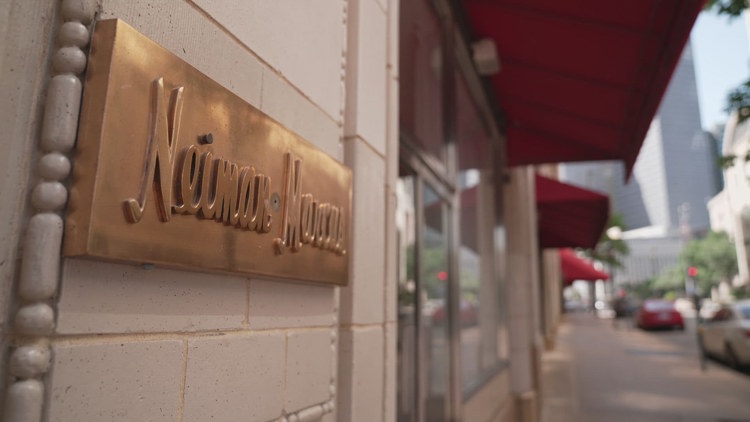DALLAS — The Neiman Marcus Company has been a staple in Dallas for over a century. Today, with rival department store Saks Fifth Avenue buying the company for $2.65 billion, the future of the store's presence in Dallas is uncertain.
With more than 5.1 million combined square feet of retail space today, let's look back at how Neiman Marcus evolved from one store to a household name in luxury.
Founding luxury
Since the beginning, Neiman Marcus has been a family affair.
The company was founded in 1907 by Abraham Lincoln "Al" Neiman, his wife, Carrie Marcus Neiman, and his brother-in-law, Herbert Marcus Sr. Their combined last names became the store's namesake.
Al Neiman and Herbert Marcus Sr. originally worked in Dallas as buyers for the two biggest department stores at the time: Sanger A. Harris and Co. and Sanger Brothers, respectively.
Seeking greener pastures, Carrie, Herbert and Al moved to Atlanta, Georgia. There, the trio operated a successful sales promotion firm. Their biggest client was a new-to-market soda pop called Coca-Cola.
The trio had grander ambitions than soft drink sales, so they got bought out for $25,000, relinquishing their sales territories for Coke in Kansas and Missouri.
From there, the three business partners moved back to Dallas and founded Neiman Marcus in 1907. The original location was opened at the intersection of Elm Street and North Field Street.
1907 was not a great year to start a business in America. The Panic of 1907 threw the country into economic recession. Nonetheless, Neiman Marcus thrived.
Though it was one of many department stores, the company worked to differentiate itself from the heavy-hitters at the time. Luxury was the standard.
The original store was decorated ornately and stocked with luxury items from New York, an uncommon sight for most Texans.
The store's customers were the ultra-wealthy of North Texas, mainly comprised of heirs to cotton empires and later oil barons.
In 1914, the original Neiman Marcus store burned down in a fire. By the end of the year, the company opened a new location at the corner of Main Street and Ervay Street. That building still stands downtown, operating as the company's headquarters to this day.
The new, larger store brought even more business, doubling the company's sales.
In the coming years, all of Herbert Marcus Sr.'s sons joined the family business, including Stanley Marcus, the future leader of the company.
In 1928, Al Neiman and Carrie Marcus divorced. In turn, he sold his share of the company for $250,000.
Expansion, expansion, expansion
The 1950s marked an era of expansion for Neiman Marcus.
At the start of the decade, Herbert Marcus Sr. died, leaving Carrie and Stanley in charge. In 1951, the company opened its first branch store in Dallas. Four years later, Neiman Marcus bought a nine-story store in Houston.
In the 1960s, the company continued that growth, opening a Fort Worth store, but lacked the capital to expand further. To make expansion possible, Neiman Marcus merged with multiple companies to form Carter, Hawley, Hale, Inc.
Through the 1970s, the company began meeting customers where they were: malls. The retailer started opening locations outside of Texas, starting with their store in Bal Harbour, Florida. From there, the company continued its growth, opening stores in over 30 U.S. cities.
After all that expansion, Neiman Marcus split from Carter, Hawley, Hale, Inc. in 1987, marking the start of another era of the company.
Buyouts and bankruptcy
Since the turn of the millennium, Neiman Marcus has passed through many hands.
In 2005, the company sold itself to Texas Pacific Group and Warburg Pincus, a pair of private equity firms.
By 2013, the company was sold again, this time for $6 billion to Ares Management and Canadian Pension. But, again, in 2015 the company became independent, and again, in 2016, the company sought another buyer.
Like many brick-and-mortar retailers, Neiman Marcus struggled during the 2020 COVID-19 pandemic. In May 2020, the company became the first department store to file for Chapter 11 bankruptcy amid the pandemic.
Today, Neiman Marcus operates 36 department stores, two Bergdorf Goodman stores and five Last Call discount stores.
Looking to the future
With the official sale of the company, many details are up in the air.
For one, we don't know whether or not the company will maintain its Dallas headquarters at the flagship location. Although, the company is under contract with the city of Dallas to keep its headquarters in Downtown Dallas through 2031.
The sale still has to close, but with Amazon backing the deal, it seems likely the sale will go through.
However, for now, Neiman Marcus will continue to operate independently.



